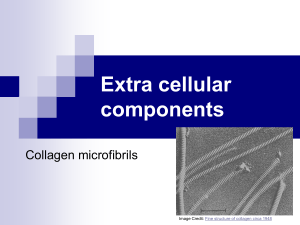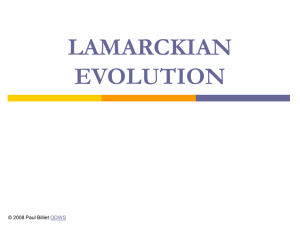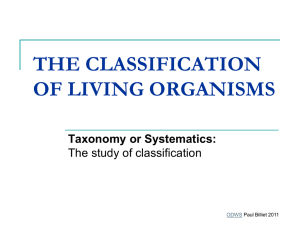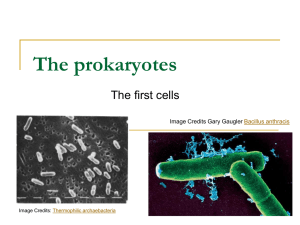Powerpoint Presentation: Natural Selection
advertisement
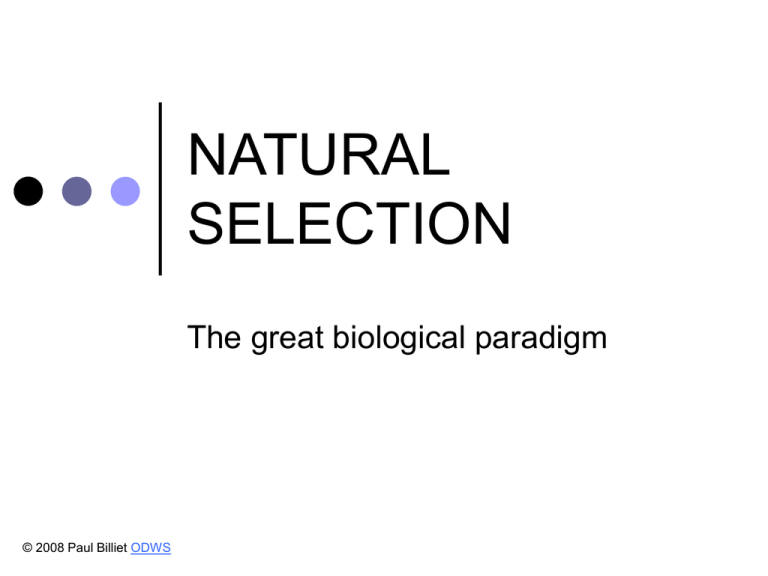
NATURAL SELECTION The great biological paradigm © 2008 Paul Billiet ODWS Observation 1: Exponential growth Populations tend to produce more offspring than the environment can support © 2008 Paul Billiet ODWS Thomas Malthus Essay on the Principle of Population (1798) Populations in nature cannot continually increase sooner or later food supply is insufficient and famine stops further growth Both Charles Darwin and Alfred Russel Wallace had read Malthus and understood the idea of exponential population growth © 2008 Paul Billiet ODWS Population Growth 1 pair of cockroaches could produce 164 000 million in 7 months Cockroach population © 2008 Paul Billiet ODWS Observation 2: Zero growth The numbers of individuals in a population remain stable In terms of population growth the population at its carrying capacity has zero growth © 2008 Paul Billiet ODWS Population growth K 3 2 Numbers 1 © 2008 Paul Billiet ODWS Time Deduction 1 Competition There must be a struggle for survival Some of the offspring produced in a generation do not survive. Darwin identified competition as a major factor limiting population sizes © 2008 Paul Billiet ODWS Observation 3: Variation Some of these variations are inherited by the offspring The mechanism of the inheritance of genes was being worked out at this time remained undiscovered by biologists until 1900 Darwin was however aware that sexual reproduction mixes variations to produce new combinations (recombinants) © 2008 Paul Billiet ODWS Neo-Darwinism The great synthesis of the 20th century Mendel’s work was able to explain some of the patterns of inheritance through the mixing that occurs during meiosis and fertilisation Darwin could not explain the origin of new variants This had to wait until the 1920s and 1930s when work began on mutations after the discovery of radiation © 2008 Paul Billiet ODWS Deduction 2: Survival of the fittest There will be a struggle for survival between the members of the population Individuals with advantageous variations will breed and produce more offspring © 2008 Paul Billiet ODWS Natural selection in action As generations pass by, the proportions of the alleles for the different variants will change in favour of those that provide the best adaptations Natural selection has been observed at work in populations of species over the past century Examples include: pesticide resistance in insects, antibiotic resistance in bacteria, industrial melanism in moths, tolerance to heavy metals in plants © 2008 Paul Billiet ODWS The Origin of Species by Natural Selection Darwin and Wallace argued that if natural selection proceeded for a long enough period of time it could bring about the evolution of new species Darwin himself favoured a long period of slow changes Recently this has been refined to include the possibility of rapid changes over a short period of time (punctuated equilibrium) © 2008 Paul Billiet ODWS Natural selection is not the only way Whether fast or slow, observing the evolution of a new species is unlikely in the lifetime of a scientist That species evolve is a fact but that they evolve by natural selection remains a theory Other mechanisms exist that can also lead to the evolution of species (e.g. genetic drift) © 2008 Paul Billiet ODWS Convergent Evolution Thylacine Thylacinus cynocephalus Species exposed to the same selective pressure in different parts of the world tend to develop the same adaptations Even though they may be completely unrelated e.g. the placental wolf and the marsupial thylacine or Tasmanian wolf © 2008 Paul Billiet ODWS Wolf Canis lupus Divergent Evolution Populations of a species that are separated and evolve under different selective pressures develop different adaptations as they diverge They are usually geographically separated so that there is a barrier to the mixing of genes © 2008 Paul Billiet ODWS Adaptive radiation Species that populate a new area where there are vacant niches will diverge and specialise as they fill the vacant niches (e.g. Darwin’s Finches on the Galapagos) © 2008 Paul Billiet ODWS
